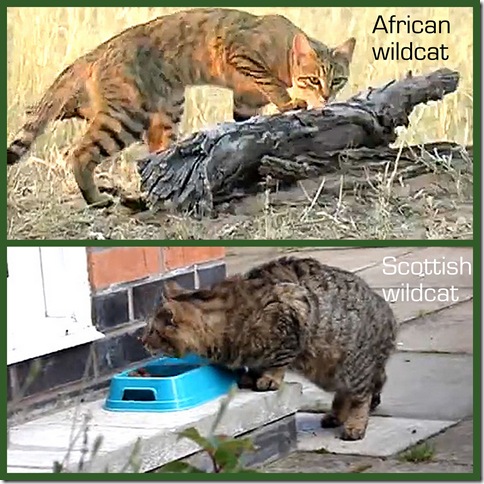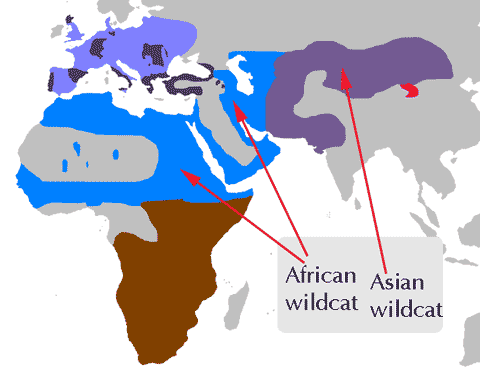Introduction
The description “African-Asian wildcat” describes two subspecies of wild cat whose combined distribution is from the southernmost tip of the African continent, through the Middle East and East towards a region north and east of India in a wide arch. Part of the reason why they are described together is because there is a dispute about classifying the various subspecies of the wildcat. It’s an ongoing discussion. These two subspecies can be treated in the same way in terms of their behaviour and how they live. Their scientific names are: Felis silvestris lybica and Felis silvestris ornata respectively. In India and Pakistan the Asian wildcat is called the desert cat although it does not inhabit true desert. The coat becomes more a shade of sandy yellow marked with small dots that tend to be in vertical lines. Today, the news media are reporting on a sighting of an Indian desert cat as they describe it. A photograph was not taken. Clearly the animal is rare in that country otherwise they wouldn’t have reported it (Dec 20, 2021). It was spotted for the first time in Madhya Pradesh’s Panna Tiger Reserve (PTR).

Note about the picture above. The strange aspect of this picture is that both ears have been ear-tipped i.e. the tops have been trimmed off. This is not explained. It may be to identify the cat to conservationist. The wildcats often inhabit areas near settlements and sometimes they crossbreed with domestic cats creating hybrids. I suspect that this individual cat has been ear-tipped by conservationists but that is a guess.
RELATED: Wild Cat Hybrids
Overview
The source for this page is the distinguished Wild Cats of the World ISBN-13: 978-0-226-77999-7, published 2002. Taxonomy of the wildcat is confusing because there is, at 2012, no clear agreement despite what Wikipedia says. Wikipedia authors say there are five subspecies. The Red List says that the latest science (2007) indicates that the wildcat can be divided into “five subspecific groups”. These are the subspecies referred to by the Wikipedia authors. The five subspecies are as follows:
| Subspecies | Scientific Name | Location |
| European wildcat | Felis silvestris silvestris | Europe |
| Chinese Mountain Cat | Felis silvestris bieti | China |
| African wildcat | Felis silvestris lybica | North Africa |
| Asiatic wildcat | Felis silvestris ornata | Asia |
| Southern African wildcat | Felis silvestris cafra | Southern Africa |
I suggest that there is still value in writing about the African-Asian wildcat as the title refers to two of the above subspecies: Felis silvestris lybica (African wildcat) and Felis silvestris ornata (Asiatic wildcat) with the exception that the Southern African wildcat has been ignored and subsumed by the African wildcat. The fact that the authors of the Wild Cats Of The World bundle these subspecies together indicates the lack of a distinct difference.
Taxonomy – Classification to species
| Kingdom | Phylum | Class | Order | Family | Genus | Species |
| Animalia | Chordata | Mammalia | Carnivora | Felidae | Felis | F. silvestris |
Introduction
The African-Asian wildcat is well known as the ancestor of the domestic cat. This species of wildcat often lives close to human settlements resulting in semi-domestication and cross breeding with domestic cats. That state of affairs appears to have been going on for 10,000 years and more. Evidence of first domestication dates from about 9,500 years ago. In the chart below the African wildcat is referred to as the “Near Eastern” wildcat.

Description
The Asian-African wildcat looks like a tabby domestic cat. The boundary is blurred by the presence of hybrid cats. The legs of the wildcat are longer than those of the domestic cat which is particularly apparent when the cat is sitting upright. It is suggested that the bronze statutes from ancient Egypt show this vertical siting position. The long legs also affect the cat’s gait. It walks like the long-legged cheetah or serval rather than the domestic cat.

This is a slender cat. It weighs between 4-6 kgs; males being larger than females. The fur is short. The European wildcat is more stocky and has longer fur. The Scottish wildcat in the picture above is a European wildcat. The difference is clear in the montage.
The cat’s coat mirrors its location and habitat. In more arid Pakistan it is a pale sandy yellow and in Africa the color is grayish to reddish. The tail has a black tip.
See: European wildcat description.
Distribution
The best way to show this is on a map.

Map above: Base map (modified) created by “Zoologist” Wikimedia commons file.
You can see that modern taxonomy has decided that the African wildcat resides in the African continent above the equator and in the Saudi Arabian peninsular together with that conglomerate of countries to its north east (marked blue).
You can see the wild cat species that are present country by country including the wildcats on this page: Wildcat of the World Map; and a map showing the distribution of all the wild cat subspecies on this page: Wildcat Distribution (note there are some differences because of the unsettled situation regarding taxonomy).
Ecology and Behavior
Due to the very wide distribution of the African-Asian wildcat we can expect a similarly wide range of habitats at differing altitudes above sea level. In African the wildcat is found to 3,000 meters above sea level.
Wildcats, like most other wild cat species (c.f. sand cat), need access to water through watercourses or at least about 4 inches of mean annual rainfall.
Examples of African-Asian wildcat habitat is as follows:
| Place | Habitat |
| Ngorongoro crater, Africa | Open grasslands. |
| Botswana | Open grassland and woodlands near water. |
| Zimbabwe | Dry woodlands and scrub |
| Kenya | Open woodlands and grasslands |
| Israel | Open Mediterranean forests and hilly areas. |
The wildcat lives side by side (sympatrically) with other wildcats and carnivores. The wildcats of the world map I created shows the list of wildcats in each country.
We have seen our domestic cats hunt. The same applies to the African-Asian wildcat. They are ground hunters/dwellers but good climbers. They are nocturnal hunters starting after sunset. The classic style is to approach as closely as possible using available cover and to pounce striking with claw and teeth. Sometimes, relatively rarely, the African wildcat hunts in groups
Prey
Primarily, prey is the rodent. Prey includes rabbits and young antelope (top weight range=4kg). Sometimes livestock such as lambs are taken. Other prey from African wildcats includes:
- lizards
- snakes
- poultry
- doves
- weavers
- insects including spiders
- skinks
- (and fruit)
The Asian wildcats prey includes:
- gerbils
- hares
- doves
- peafowl
- sparrows
- rats
The African and Asian wildcats are adaptable in terms of prey selection.
Socialization
Vocalisation: similar to domestic cat. Range size probably in the order of 1.6-12.7 km² (depending on sex of cat). Highly territorial cat. Scent marking heavily utilised.
Reproduction/Development
| Event | Time Scale |
| Litter size | 1-5 kittens (averge=3). |
| Number litters per year | Captive wildcats=2. |
| Gestation (pregnancy) | 56-65 days. |
| Estrus (on heat) | 2-8 days and come into heat several times annually. |
| Den | Underground, rock cevices, under brush. |
| Kitten weight at birth | 80-120 grams. |
| Kittens mobile | At 3 weeks. |
| Start hunting | Accompany mother on hunting trips 3 months of age. |
| Kitten independent | About 6 months of age. |
Status in Wild
The IUCN Red List™ classifies this wild cat species as Least Concern with decreasing population due mainly to hybridization, road kill, human persecution, poisoning of the prey of the wildcat (Chinese desert/mountain cat) this leads to the poisoning of the cat and a loss of prey, habitat loss and trade in skins.

As you can see Least Concern is a classification in terms of survival in the wild that says that there are currently (2012) little concerns in this regard.

